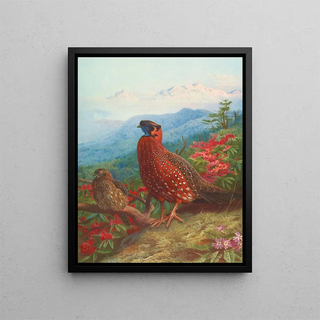Painting The Tragopan Satyr - Archibald Thorburn | Art print


View from behind

Frame (optional)
Art print Le Satyre tragopan - Archibald Thorburn – Engaging introduction
In the fascinating world of wildlife art, "Le Satyre tragopan" by Archibald Thorburn stands out for its beauty and authenticity. This piece, depicting a majestic bird, evokes not only the splendor of fauna but also the delicacy of the connection between art and nature. Thorburn, a master of the early 20th century, manages to capture the very essence of his subject, revealing harmony between the animal and its environment. The art print of this work allows the viewer to enter a universe where nature is celebrated, where each feather seems to vibrate with its own life. Through this piece, the artist invites us to contemplate the fragile beauty of our natural world.
Style and uniqueness of the work
Archibald Thorburn's style is characterized by striking realism, a feature fully expressed in "Le Satyre tragopan." The precision of details, vibrant colors, and delicate textures give the work a depth that transcends a simple animal portrait. Each brushstroke is an ode to nature, where light plays on the feathers of the tragopan, creating a dance of shadows and highlights that captivates the eye. The artist does not merely reproduce a bird; he evokes an atmosphere, a sense of wonder at wild beauty. This attention to detail and ability to convey emotion make this work a true masterpiece, inviting contemplation and appreciation of wild life.
The artist and his influence
Archibald Thorburn, born in 1860, is often regarded as one of the greatest naturalist artists of his time. His passion for nature and his commitment to representing fauna with scientific accuracy marked his oeuvre. Influenced by Scottish landscapes and the surrounding biodiversity, Thorburn was able to combine his love of nature with undeniable artistic talent. His works, including "Le Satyre tragopan," reflect an era when conservation of nature was beginning to be felt, and where art could play a role in raising awareness for this cause. Thorburn's legacy continues to inspire.

Matte finish

View from behind

Frame (optional)
Art print Le Satyre tragopan - Archibald Thorburn – Engaging introduction
In the fascinating world of wildlife art, "Le Satyre tragopan" by Archibald Thorburn stands out for its beauty and authenticity. This piece, depicting a majestic bird, evokes not only the splendor of fauna but also the delicacy of the connection between art and nature. Thorburn, a master of the early 20th century, manages to capture the very essence of his subject, revealing harmony between the animal and its environment. The art print of this work allows the viewer to enter a universe where nature is celebrated, where each feather seems to vibrate with its own life. Through this piece, the artist invites us to contemplate the fragile beauty of our natural world.
Style and uniqueness of the work
Archibald Thorburn's style is characterized by striking realism, a feature fully expressed in "Le Satyre tragopan." The precision of details, vibrant colors, and delicate textures give the work a depth that transcends a simple animal portrait. Each brushstroke is an ode to nature, where light plays on the feathers of the tragopan, creating a dance of shadows and highlights that captivates the eye. The artist does not merely reproduce a bird; he evokes an atmosphere, a sense of wonder at wild beauty. This attention to detail and ability to convey emotion make this work a true masterpiece, inviting contemplation and appreciation of wild life.
The artist and his influence
Archibald Thorburn, born in 1860, is often regarded as one of the greatest naturalist artists of his time. His passion for nature and his commitment to representing fauna with scientific accuracy marked his oeuvre. Influenced by Scottish landscapes and the surrounding biodiversity, Thorburn was able to combine his love of nature with undeniable artistic talent. His works, including "Le Satyre tragopan," reflect an era when conservation of nature was beginning to be felt, and where art could play a role in raising awareness for this cause. Thorburn's legacy continues to inspire.
12,34 €






